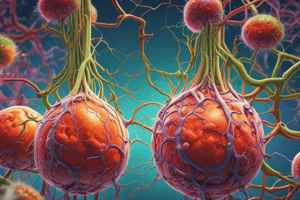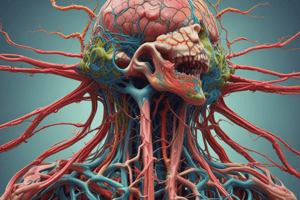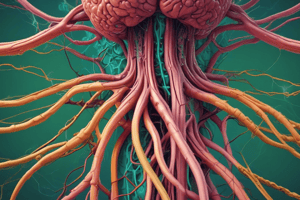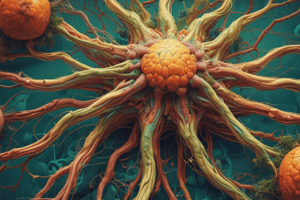Podcast
Questions and Answers
What is the primary objective of the lymphatic system?
What is the primary objective of the lymphatic system?
- To produce proteins and ions
- To regulate body temperature
- To maintain blood volume and return leaked fluid to the circulatory system (correct)
- To protect the host from pathogens
What is the main difference between plasma and interstitial fluid?
What is the main difference between plasma and interstitial fluid?
- presence of blood cells (correct)
- Percentage of water
- Location within the body
- Composition of proteins and ions
What is the term for the fluid that surrounds tissue cells?
What is the term for the fluid that surrounds tissue cells?
- Interstitial fluid (correct)
- Tissue fluid
- Lymph
- Transudate
What is the fluid that has leaked from blood vessels and is picked up by lymphatic capillaries?
What is the fluid that has leaked from blood vessels and is picked up by lymphatic capillaries?
What is the percentage of water in plasma?
What is the percentage of water in plasma?
What is the term for the fluid that is similar to interstitial fluid but contains no cells and only small proteins?
What is the term for the fluid that is similar to interstitial fluid but contains no cells and only small proteins?
What is the fluid that leaks out and returns back to the circulatory system?
What is the fluid that leaks out and returns back to the circulatory system?
What do lymph capillaries have compared to the interstitium?
What do lymph capillaries have compared to the interstitium?
What do lymphatic vessels ultimately empty into?
What do lymphatic vessels ultimately empty into?
What is the function of the spleen in the Lymphatic/Immune System?
What is the function of the spleen in the Lymphatic/Immune System?
What type of cell is a macrophage?
What type of cell is a macrophage?
Where are lymphoid tissues commonly found?
Where are lymphoid tissues commonly found?
What is the function of lymphatic nodules?
What is the function of lymphatic nodules?
What is the name of the lymphatic nodule in the ileum of the small intestine?
What is the name of the lymphatic nodule in the ileum of the small intestine?
What is the function of the appendix?
What is the function of the appendix?
What is the result of excessive hygiene and sanitizing?
What is the result of excessive hygiene and sanitizing?
What is the function of adenoids in the nasopharynx?
What is the function of adenoids in the nasopharynx?
Where are the platine tonsils located?
Where are the platine tonsils located?
What is the function of the spleen?
What is the function of the spleen?
What is the function of the thymus gland?
What is the function of the thymus gland?
What is the result of the immune system attacking one's own tissue?
What is the result of the immune system attacking one's own tissue?
What is the location of the thymus gland?
What is the location of the thymus gland?
What is the function of lymph nodes?
What is the function of lymph nodes?
What is the role of the spleen in immune/antigenic competence?
What is the role of the spleen in immune/antigenic competence?
What is the function of lymphatic tissue in the spleen?
What is the function of lymphatic tissue in the spleen?
What happens to the thymus gland with age?
What happens to the thymus gland with age?
What is the primary function of red bone marrow?
What is the primary function of red bone marrow?
What is the term for the process of forming blood cells?
What is the term for the process of forming blood cells?
What type of bone marrow increases with age?
What type of bone marrow increases with age?
What is the function of granulocytes?
What is the function of granulocytes?
What is the term for the first line of defense against disease?
What is the term for the first line of defense against disease?
What is the function of histamine in inflammation?
What is the function of histamine in inflammation?
What is the term for the response of the body to tissue damage?
What is the term for the response of the body to tissue damage?
What type of cells mature in the thymus gland?
What type of cells mature in the thymus gland?
What is the term for the ability of the body to resist disease?
What is the term for the ability of the body to resist disease?
What is the term for the third line of defense against disease?
What is the term for the third line of defense against disease?
What type of cells do not have MHC type I?
What type of cells do not have MHC type I?
What is the primary function of Cytotoxic T cells?
What is the primary function of Cytotoxic T cells?
What is the purpose of MHC markers?
What is the purpose of MHC markers?
What is the goal of matching MHC markers in organ transplantation?
What is the goal of matching MHC markers in organ transplantation?
What happens when T cells contact Antigen Presenting Cells?
What happens when T cells contact Antigen Presenting Cells?
What is the characteristic of viruses?
What is the characteristic of viruses?
What is the result of increased permeability of capillaries during inflammation?
What is the result of increased permeability of capillaries during inflammation?
What is the role of Kinin in the inflammatory response?
What is the role of Kinin in the inflammatory response?
What is the function of B cells in the immune response?
What is the function of B cells in the immune response?
What is the difference between antigens and immunogens?
What is the difference between antigens and immunogens?
What is the role of T-cells in the immune response?
What is the role of T-cells in the immune response?
What is the function of antigen-presenting cells (APCs)?
What is the function of antigen-presenting cells (APCs)?
What is the role of the thymus in T-cell development?
What is the role of the thymus in T-cell development?
What is the function of Memory B cells?
What is the function of Memory B cells?
What is the term for the fluid that surrounds tissue cells?
What is the term for the fluid that surrounds tissue cells?
What is the result of vasodilation of arterioles during inflammation?
What is the result of vasodilation of arterioles during inflammation?
What type of cells are present in large quantities in lymphatic tissue?
What type of cells are present in large quantities in lymphatic tissue?
What is the function of lymphocytes in lymphatic tissue?
What is the function of lymphocytes in lymphatic tissue?
What type of connective tissue makes up lymphatic tissue?
What type of connective tissue makes up lymphatic tissue?
What is the origin of macrophages in lymphatic tissue?
What is the origin of macrophages in lymphatic tissue?
What is the role of macrophages in lymphatic tissue?
What is the role of macrophages in lymphatic tissue?
Where do pre-thymocytes mature into T-cells?
Where do pre-thymocytes mature into T-cells?
Which organ produces immature T-cells?
Which organ produces immature T-cells?
What is one crucial function of the thymus gland in the immune system?
What is one crucial function of the thymus gland in the immune system?
What is a possible consequence of the immune system attacking the body’s own tissues?
What is a possible consequence of the immune system attacking the body’s own tissues?
Why is exposure to various pathogens important during childhood?
Why is exposure to various pathogens important during childhood?
Which condition is NOT an example of an autoimmune disease?
Which condition is NOT an example of an autoimmune disease?
Study Notes
The Lymphatic and Immune Systems
- The lymphatic system is responsible for maintaining blood volume and protecting the body from infection, while the immune system is responsible for protecting the body from foreign substances and disease.
Fluid Compartments
- The body contains two main fluid compartments: intracellular fluid and extracellular fluid.
- Intracellular fluid is the fluid within cells, making up about 40% of the body's water content.
- Extracellular fluid is the fluid outside of cells, making up about 20% of the body's water content.
- Extracellular fluid is further divided into:
- Plasma (the fluid portion of blood, making up about 5% of the body's water content)
- Interstitial fluid (the fluid surrounding tissue cells, making up about 15% of the body's water content)
- Lymph (a clear fluid that circulates through the lymphatic vessels, making up about 5% of the body's water content)
Lymphatic System Function
- The lymphatic system has two main functions:
- To return fluid that has leaked from blood vessels back to the bloodstream (maintaining blood volume)
- To protect the body from infection (immune function)
Lymphatic System Organs
- The lymphatic system includes the following organs:
- Thymus gland
- Bone marrow
- Spleen
- Lymph nodes
- Lymphatic vessels
- Lymphatic ducts
- Tonsils
- Lymphoid tissues (found in the mucous membranes of the digestive, respiratory, urinary, and reproductive tracts)
Spleen
- The spleen is the largest mass of lymphatic tissue in the body.
- The spleen filters the blood, removing old or damaged red blood cells and platelets.
- The spleen also stores red blood cells and platelets, releasing them into the bloodstream as needed.
Thymus Gland
- The thymus gland is responsible for the maturation of T-lymphocytes (a type of white blood cell involved in the immune response).
- The thymus gland is located in the superior mediastinum, superior to the heart.
- The thymus gland is large in infancy and atrophies with age.
Bone Marrow
- Bone marrow is responsible for the production of blood cells, including red blood cells, platelets, and white blood cells.
- Bone marrow is found in the medullary cavity of bones.
- There are two types of bone marrow: red bone marrow and yellow bone marrow.
- Red bone marrow is responsible for the production of blood cells, while yellow bone marrow is primarily composed of fat cells.
Immune Response
- The immune response involves the recognition of pathogens (foreign substances) by the immune system and the activation of immune cells to eliminate the pathogen.
- There are two main types of immune responses:
- Humoral immune response (involving B-lymphocytes and antibodies)
- Cell-mediated immune response (involving T-lymphocytes)
Humoral Immune Response
- B-lymphocytes recognize pathogens and produce antibodies, which bind to the pathogen, marking it for destruction.
- There are two types of B-cells:
- Plasma cells (produce antibodies)
- Memory B-cells (remember the pathogen and can rapidly produce antibodies upon re-exposure)
Cell-Mediated Immune Response
- T-lymphocytes recognize pathogens and directly kill infected cells or produce chemical signals that activate other immune cells.
- There are several types of T-cells, including:
- Cytotoxic T-cells (kill infected cells)
- Helper T-cells (activate other immune cells)
- Regulatory T-cells (regulate the immune response)
Antigens and Antibodies
- Antigens are substances that can trigger an immune response.
- Antibodies are proteins produced by B-cells that bind to specific antigens.
- Antibodies have a specific shape that allows them to bind to a particular antigen.
Inflammation
- Inflammation is a generic response to tissue damage or infection.
- The inflammatory response involves the activation of immune cells, the dilation of blood vessels, and the movement of immune cells to the site of injury or infection.
Three Lines of Defense
- The body has three lines of defense against infection:
- Intact skin and mucous membranes (physical barrier)
- Inflammatory response (non-specific immune response)
- Immune response (specific immune response)
Lymphatic Tissue Composition
- Lymphatic tissue is composed of reticular connective tissue
- Fibroblasts are a type of cell found in lymphatic tissue
- Macrophages, derived from monocytes that have left the blood, are present in lymphatic tissue
- Lymphocytes are abundant in lymphatic tissue
- Lymphocytes serve as a defense mechanism, interacting with harmful substances
cell function
- Macrophages are monocytes that have migrated out of the blood
- Lymphocytes play a crucial role in responding to harmful substances
Thymus Gland Functions
- The thymus gland does not produce blood cells; only the red bone marrow produces blood cells.
- Bone marrow produces immature T-cells, also known as pre-thymocytes, which then migrate to the thymus gland.
- In the thymus gland, pre-thymocytes differentiate into mature T-cells, making them ready to perform their immune functions.
Development of T-Cells
- Pre-thymocytes leave the red bone marrow and circulate to the thymus gland, where they mature into T-cells.
- The thymus gland plays a crucial role in the maturation of T-cells, ensuring they can recognize and distinguish between self and non-self.
Immune System Functions
- The thymus gland is responsible for half of the immune system's functions, particularly in recognizing self vs. non-self T-cells.
- The thymus gland helps the body distinguish between its own tissues and foreign substances, preventing autoimmune responses.
Autoimmune Diseases
- Autoimmune diseases, such as psoriasis and arthritis, occur when the body's immune system mistakenly attacks its own tissues.
- Early exposure to various substances in childhood may help the body develop a stronger immune system, reducing the risk of autoimmune diseases later in life.
Studying That Suits You
Use AI to generate personalized quizzes and flashcards to suit your learning preferences.
Description
This quiz covers the functions and objectives of the lymphatic and immune systems, including the circulation of fluids and maintenance of blood volume.




